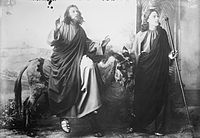Oberammergau Passion Play
The Oberammergau Passion Play (German: Oberammergauer Passionsspiele) is a passion play that has been performed every 10 years from 1634 to 1674 and each decadal year since 1680 (with a few exceptions) by the inhabitants of the village of Oberammergau, Bavaria, Germany. It was written by Othmar Weis, J A Daisenberger, Otto Huber, Christian Stuckl, Rochus Dedler, Eugen Papst, Marcus Zwink, Ingrid H Shafer, and the inhabitants of Oberammergau, with music by Dedler.[1] Since its first production it has been performed on open-air stages in the village. The text of the play is a composite of four distinct manuscripts dating from the 15th and 16th centuries.[2]
The play is a staging of Jesus' passion, covering the short final period of his life from his visit to Jerusalem and leading to his execution by crucifixion. It is the earliest continuous survivor of the age of Christian religions vernacular drama.
The 2020 play was postponed until 2022 due to the pandemic in Europe.[3][4][5]
Background[edit]
Vow[edit]
According to legend: an outbreak of bubonic plague devastated Bavaria during the Thirty Years' War (1618–1648). Bad Kohlgrub was so depopulated that only two married couples remained alive. The village of Oberammergau remained plague-free until 25 September 1633, when a man named Kaspar Schisler returned home after working in the nearby village of Eschenlohe. Over the next 33 days, 81 villagers would die, half of Oberammergau's population. On 28 October 1633, the villagers vowed that if God spared them from the plague, they would perform a play every 10 years depicting the life and death of Jesus. Nobody died of plague in Oberammergau after that vow, and the villagers kept their word to God by performing the passion play for the first time in 1634.[6]: 101–111
The legend is a distorted account of the actual plague. There was an outbreak of plague in Oberammergau, but it took place from September 1632 to March 1633, when there were a total of 84 deaths from all causes. Deaths followed an epidemic curve instead of ending suddenly. There was one death in September 1632, rising to 20 deaths in March 1633, and ending with one death in July 1633. There is also no record of a man named Kaspar Schisler. Only two couples got married in Bad Kohlgrub in 1634, instead of only two couples surviving the plague. There were 39 marriages in Bad Kohlgrub in 1635, so hundreds of villagers must have survived.[6]: 101–111
The errors may have been introduced by the retelling of an oral history that was not written down until 1733. The original work has been lost, and only fragments of the oral history survive as quotations in other works. The legend is told in the play The Plague of 1633 (German: Die Pestnot Anno 1633), which used to be performed the year before the Passion Play. It was retold as recently as the 1999 vow ceremony, which marked the beginning of rehearsals for the 2000 play.[6]: 101–111 The town of Oberammergau now claims that Kaspar Schisler came home for a church festival in 1632 instead of 1633.[7]
Performance[edit]
The production involves over 2,000 people: actors, musicians, stage technicians, and others, all residents of the village.[8] The play comprises spoken dramatic text, musical and choral accompaniment and tableaux vivants, which are scenes from the Old Testament depicted for the audience by motionless actors accompanied by verbal description. These scenes are the basis for the typology, the interrelationship between the Old and New Testaments, of the play. They include a scene of King Ahasuerus rejecting Vashti in favor of Esther, the brothers selling Joseph into slavery in Egypt, and Moses raising up the nehushtan (bronze serpent) in the wilderness. Each scene precedes that section of the play that is considered to be prefigured by the scene. The three tableaux mentioned are presented to the audience as prefiguring Christianity superseding Judaism, Judas selling information on the location of Jesus, and the crucifixion of Jesus.[citation needed]
The evolution of the Passion Play was about the same as that of the Easter Play, originating in the ritual of the Latin Church, which prescribes, among other things, that the Gospel on Good Friday should be sung in parts divided among various persons.[citation needed]


